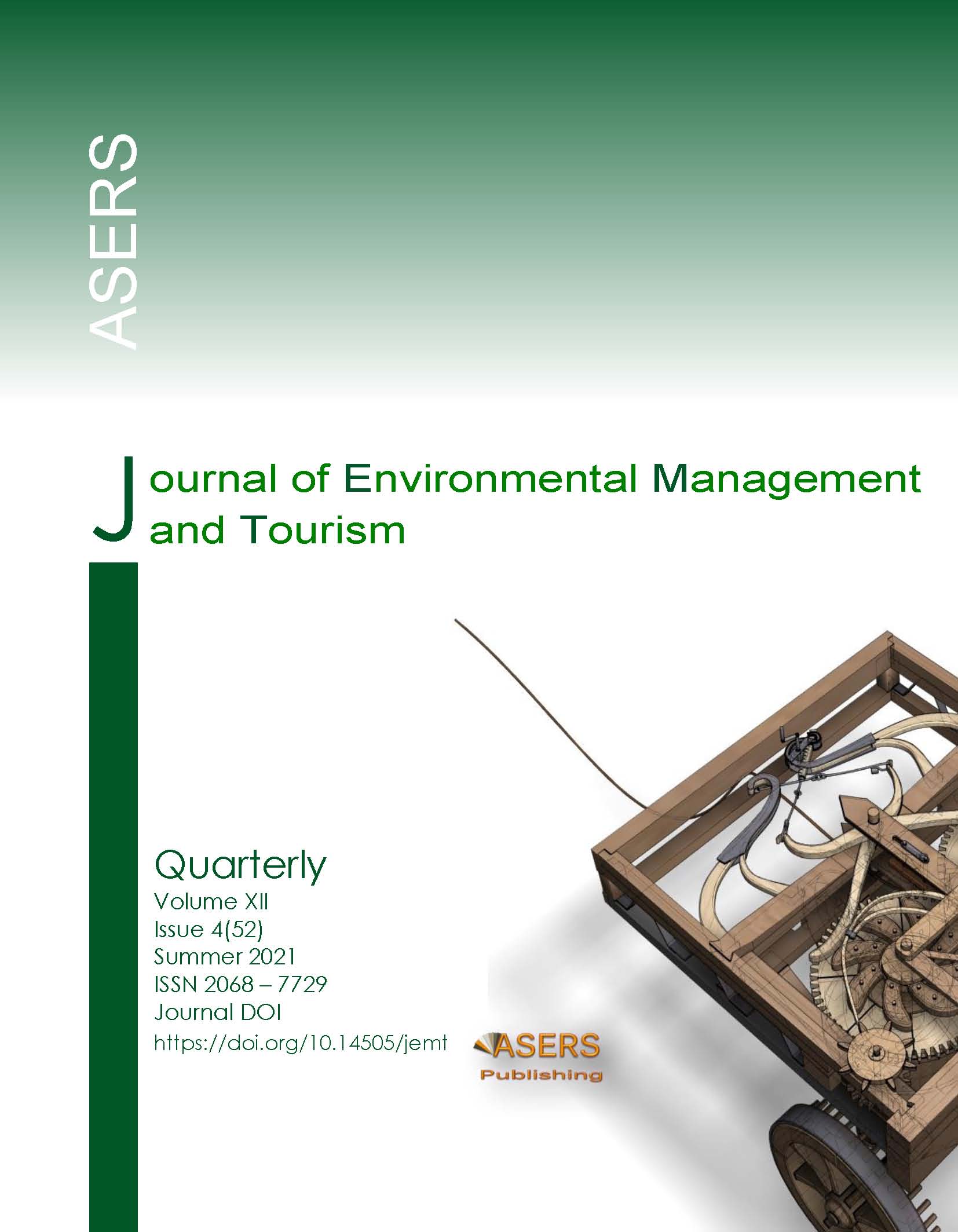Innovation of Tourism Supply Chain Management: A New Agenda for Optimization. The Case of Kazakhstan
Abstract
Despite the recognition of tourism as a priority sector, the development pace and indicators remain low. Innovation management methods are required that will positively affect the entire industry. The main article goal is to identify the problems of tourism sector development for the positive effects achievement and the system transition to a new, qualitative one, as well as identifying barriers and constraints. The problems raised by the authors in the article require comprehensive study and analysis. The authors conducted a comparative analysis of travel and tourism competitiveness index of the Republic of Kazakhstan for 2017 and 2019 years. The authors also analyzed the main indicators of the development of the tourism sector, financial and economic activities of tourism companies in the Republic of Kazakhstan, studied the tourism potential of Nur-Sultan city and Akmola region. As a result of the conducted research, conclusions are drawn, and recommendations are given.
References
[2] Baiburiev, R., Lorant, D., Sholpan, A., Aiman, Z., and Artemyev, A. 2018. Impacts of tourism activities on economy of Kazakhstan. GeoJournal of Tourism & Geosites 22 (2): 480. DOI:https://doi.org/10.30892/gtg.22217-304.
[3] Buhalis, D., and Foerste, M. 2015. SoCoMo marketing for travel and tourism: Empowering co-creation of value. Journal of Destination Marketing & Management 4 (3): 151–61. DOI:https://doi.org/10.1016/j.jdmm.2015.04.001.
[4] Buyukkeklik, A., Ozoglu, B., and Kemer, E. 2014. Buyer-supplier relationship in tourism supply chains: A research in Cappadocia region in Turkey. Journal of Applied Sciences 14 (7): 660–8. DOI:https://doi.org/10.3923/jas.2014.660.668.
[5] Camisón, C., and Monfort-Mir, V.M. 2012. Measuring innovation in tourism from the Schumpeterian and the dynamic-capabilities perspectives. Tourism Management 33 (4): 776–89. DOI:https://doi.org/10.1016/j.tourman.2011.08.012.
[6] Chen, D. 2009. Innovation of tourism supply chain management. 2009 International Conference on Management of e-Commerce and e-Government, IEEE, 310–3. DOI:https://doi.org/10.1109/ICMeCG.2009.79.
[7] Gabdullina, L., et al. 2020. Transport and logistics innovations in supply chain management: evidence from Kazakhstan. Uncertain Supply Chain Management 8 (2): 255–66. DOI:http://doi.org/10.5267/j.uscm.2020.1.002.
[8] Hjalager, A.-M. 1997. Innovation patterns in sustainable tourism. Tourism Management 18 (1): 35–41. DOI:https://doi.org/10.1016/S0261-5177(96)00096-9.
[9] Hjalager, A.-M. 2002. Repairing innovation defectiveness in tourism. Tourism Management 23 (5): 465–74. DOI:https://doi.org/10.1016/S0261-5177(02)00013-4.
[10] Hjalager, A.-M. 2010. A review of innovation research in tourism. Tourism Management 31 (1): 1–12. DOI:https://doi.org/10.1016/j.tourman.2009.08.012.
[11] Hjalager, A.-M., and Nordin, S. 2011. User-driven innovation in tourism - A review of methodologies. Journal of Quality Assurance in Hospitality & Tourism 12 (4): 289–315. DOI:https://doi.org/10.1080/1528008X.2011.541837.
[12] Hjalager, A.-M. 2013. 100 innovations that transformed tourism. Journal of Travel Research 54 (1): 3–21. DOI:https://doi.org/10.1177%2F0047287513516390.
[13] Hong, T.K., and Zailani, S. 2011. Service supply chain practices from the perspective of Malaysian tourism industry. 2011 IEEE International Conference on Industrial Engineering and Engineering Management, IEEE, 539–43. DOI:https://doi.org/10.1109/IEEM.2011.6117975.
[14] Latypova, E.N. 2014. Innovative activity at tourism enterprises: factors and problems of development. Vestnik Universiteta 12: 50–3.
[15] Mihardjo, L.W., Wasono, Sasmoko, S., Alamsyah, F., and Elidjen, E. 2020. Maximising co-creation strategy through integration of distinctive capabilities and customer experiences in supply chain management. Uncertain Supply Chain Management 8(1): 187–96. DOI:http://doi.org/10.5267/j.uscm.2019.7.005.
[16] Najda-Janoszka, M., and Kopera, S. 2014. Exploring barriers to innovation in tourism industry - The case of southern region of Poland. Procedia - Social and Behavioral Sciences, 110: 190–201. DOI:https://doi.org/10.1016/j.sbspro.2013.12.862.
[17] Miyazhdenovna N.A., Zhaslanovna, S.E., Anuarbekkyzy, N.G., Nurlanovna, A.L., and Tulegenovna, Z.K. 2020. The role of management accounting techniques in determining the relationship between purchasing and supplier management: A case study of retail firms in Kazakhstan. Uncertain Supply Chain Management 8(1): 149–64. DOI:http://doi.org/10.5267/j.uscm.2019.7.008.
[18] Ottenbacher, M.C. 2007. Innovation management in the hospitality industry: different strategies for achieving success. Journal of Hospitality & Tourism Research 31 (4): 431–54. DOI:https://doi.org/10.1177%2F1096348007302352.
[19] Rodríguez, I., Williams, A.M., and Hall, C.M. 2014. Tourism innovation policy: implementation and outcomes. Annals of Tourism Research 49: 76–93. DOI:https://doi.org/10.1016/j.annals.2014.08.004.
[20] Shvets, Y.Y. 2015. Conditions of sustainable development of tourism at the regional level. Humanities, Socio-Economic and Social Sciences 2: 350–8.
[21] Sutono, A. 2019. Supply chain management: implementation issues and research opportunities in tourism industry. Uncertain Supply Chain Management 7(3): 427–38. http://dx.doi.org/10.5267/j.uscm.2018.12.004.
[22] Tovma, N.A., Shurenov, N.B., Bimendiyeva, L.A., Kozhamkulova, Z.T., and Akhmetova, Z.B. 2020. Territorial marketing and its role in determining regional competitiveness. Evaluating supply chain management. Uncertain Supply Chain Management, 8(1): 1–16. DOI:http://doi.org/10.5267/j.uscm.2019.10.001
[23] Vartanova, M.L.2017. Innovation activity in tourism and its state regulation. Journal of International Economic Affairs 7(2): 209–22.
[24] Vetrov, I.N., and Lapshin, V.Y. 2016. Innovative mechanism of management as factor of sustainable and safe development of tourist branch. Forestry Magazine 61(21): 212–20. DOI:https://doi.org/10.12737/18744.
[25] Zhang, X., Song, H., and Huang, G.Q. 2009. Tourism supply chain management: A new research agenda. Tourism Management 30(3): 345–58. DOI: https://doi.org/10.1016/j.tourman.2008.12.010.
[26] Government of the Republic of Kazakhstan. 2019. State Program for Tourism Development in the Republic of Kazakhstan No.360. Adilet. http://adilet.zan.kz/rus/docs/P1900000360
[27] Government of the Republic of Kazakhstan. 2017. Concept of tourism industry development of the Republic of Kazakhstan, No. 406. Adilet. http://adilet.zan.kz/rus/docs/P1700000406
[28] Ministry of Industry and New Technologies of the Republic of Kazakhstan. 2014. State program of industrial and innovative development of the Republic of Kazakhstan for 2015-2019. Belglas BV. https://belglas.files.wordpress.com/2016/02/eng.pdf
[29] Statistical digest. 2016. Tourism of Kazakhstan 2014-2018. CEIC https://www.ceicdata.com/en/kazakhstan/tourism-statistics
[30] WIPO. 2019. Global Innovation Index 2019. https://www.wipo.int/edocs/pubdocs/ru/wipo_pub_gii_2019_keyfindings.pdf
[31] World Economic Forum. 2019a. The Travel and Tourism Competitiveness Report 2019. http://reports.weforum.org/travel-and-tourism-competitiveness-report-2019/country-profiles/#economy=KAZ
[32] World Economic Forum. 2019b. The Global Competitiveness Report 2019. http://www3.weforum.org/docs/WEF_TheGlobalCompetitivenessReport2019.pdf
Copyright© 2025 The Author(s). Published by ASERS Publishing 2025. This is an open access article distributed under the terms of CC-BY 4.0 license.
